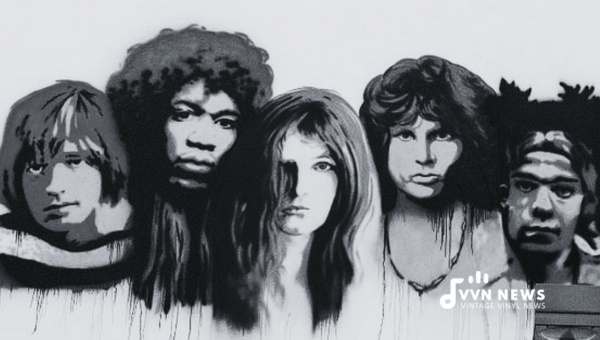The “27 Club” is a term that sends shivers down the spine of music enthusiasts across all ages and genres.
The Curse of the 27 Club refers to the uncanny number of extraordinarily talented musicians who have tragically passed away at the tender age of 27.
As I delved deeper into this phenomenon, I realized that this eerie coincidence was marked by a collection of artists whose voices have not only defined a generation but have also left an indelible imprint on our cultural psyche.
These musicians belong to what we now colloquially refer to as the “27 Club”.
This particular group resonates so profoundly within us due to their exceptional musical gifts, and their premature passing leaves us with an insatiable longing for what could have been.
Each story behind these members is characterized by rapid rises to fame and touching brilliance, making their abrupt departures from our world even more devastating.
What is the 27 Club?

The 27 Club is an informal and, frankly, tragic group of famous musicians who have met their untimely demise at the ripening age of 27.
This unnerving coincidence was first observed in the late 1960s, but the term “27 Club” didn’t gain widespread recognition until Kurt Cobain, the iconic frontman for Nirvana, died in 1994.
Also Read: 25 Richest Musicians In The World And Their Worth [Ranking]
Founding Members and Their Impact
Often deemed as trailblazing artists who shaped unique sounds, the key members include Brian Jones from The Rolling Stones, Jimi Hendrix, a guitar virtuoso and pioneer of psychedelic rock music, Janis Joplin, an influential blues-rock vocalist known for her raspy voice and vulnerable lyrics, and Jim Morrison, the enigmatic frontman for The Doors.
Establishing many sonic landscapes that have stood the test of time, these artists have solidified their status as cultural icons.
Further pushing this eerie association into public consciousness was Kurt Cobain and Amy Winehouse.
Their tremendous talent, paired tragically with their intense personal struggles, made their addition to this grim fraternity almost expected by dreading followers.
Historically speaking, though eerie, these correlations lend no evidence to causal relationships.
Nevertheless, they enable us to explore the unique musical legacies left behind and the harsh pressures fame can solicit on young talents.
The Tragic Losses: Iconic Artists Who Joined the Club
The stories behind the previously mentioned tragic loss are haunting, and they linger like specters in the hallowed halls of music history, often outliving the creative genius they stood for.
Let’s dive into the tales of the two most iconic members.
Jimi Hendrix
The demise of Jimi Hendrix shook the world in 1970. Known as one of just two artists who could make a guitar ‘weep,’ his short-lived career was packed with innovation and groundbreaking skill, inspiring guitarists even today.
Despite being on top of his musical game, off-stage, Hendrix’s life was a toxic blend of professional pressures, tumultuous personal relationships, and substance abuse.
His troubled life came screeching to a halt when he tragically aspirated on his vomit following an overdose of sleeping pills, leaving behind unanswered questions and unfulfilled potential.
Amy Winehouse
Flash forward to our modern era; we saw another striking talent lost to this grim tally.
The incomparable Amy Winehouse, beloved for her depth-defying vocals and soulful lyrics that emanated raw emotion, straddled stardom, and demon-like struggles with addiction publically.
Amy couldn’t keep her demons at bay and relapsed into alcoholism after a period of abstinence.
Her death in 2011 from accidental alcohol poisoning painted an all too familiar image synonymous with the 27 Club – unparalleled talent marked by severe struggles with substance abuse.
In both these superstardoms cut short, we notice a disturbingly frequent theme: fame bringing equal measure brilliance to their artistry but darkness into their personal lives.
Also Read: ASCAP Vs BMI [Choosing The Right PRO For Musicians]
The Cursed Fame: Behind Success and Tragedy

Fame and fortune bring unparalleled adoration, but for vulnerable artists, they may become the breeding ground for overwhelming pressure and temptations.
Often, this sudden spotlight leaves talented youngsters ill-equipped to handle the intensity of their newfound status.
Fact or Fiction: The Correlation Between Fame and Tragic Endings
Undeniably, there is a correlation between fame at a young age and tragic endings.
A study published in the British Medical Journal studied 1053 North American and European musicians between 1950-2010, finding that fame elevated caricatures of the rockstar lifestyle – full of excess substances, turbulent relationships, and often selfish indulgences.
This subsequently made them more prone to premature deaths.
It isn’t just coincidence, then; a perfect storm brewing for tragedy. Let’s strip apart this connection further.
Navigating the Pressures of Fame
Members thrown into the limelight contend with unimaginable expectations from millions of fans worldwide.
Their profession compels them to meet these demands tirelessly. Yet how do we expect them to communicate about their suffering when they are viewed as figures symbolizing joy?
Perhaps Kurt Cobain said it best: “I’m worse at what I do best / And for this gift I feel blessed.”
This speaks volumes about the disillusionment that comes with fame – being recognized for an innate talent but feeling cursed by it.
Facing Temptation: Substances, Relationships & The Rock’n’Roll Lifestyle
The association between musicians and substance abuse isn’t novel – their professional milieu is saturated with its allure.
The ‘heroin chic’ prevalent in the early 90s was romanticized by the media – leading many impressionable artists down a destructive pathway.
It’s imperative to remember those we’ve lost, not merely as victims of a ‘curse’, but as human beings subjected to an unforgiving spotlight.
We must foster understanding and compassion towards the underlying pressures of fame that can potentially spiral into tragedy.
Pervasive narratives surrounding the ’27 Club’ might overlook the silent shout for help hidden behind iconic personas.
We ought to pay more attention to our heroes’ battles behind curtains when applause fades. We don’t want another name added to the grim tally of talented lives lost too soon.
Also Read: C Sharp Minor Chords [Simple Guide For Aspiring Musicians]
Psychological Aspects
It is crucial to approach the phenomenon of the 27 Club not from a morbid fascination but from a perspective seeking to understand the mental anguish that frequently accompanies fame and success.
The Stress of Stardom
The glamour and allure of stardom often obscure the intense pressures and expectations that ride on performers’ shoulders.
They are under constant scrutiny, both professionally and personally. The stress often leads them into a tumultuous emotional state, frequently negatively impacting their mental health.
Depression, for instance, is no stranger to many musicians who’ve reached meteoric heights.
Success most times does not alleviate feelings of sadness or loneliness; in fact, it can heighten them in an environment where they feel they have no one to turn to or relate with.
Kurt Cobain eloquently vocalized this emotional strain when he said, “If you’re a mean person, you’re going to come back as a fly and eat poop.”
His tragically prophetic words indicate many artists’ dread as they grapple with fame’s genuine cost.
The Prescribed Escape: Substance Misuse
Some musicians use substance misuse as a perceived safety net to cope with this intense pressure.
The music industry’s often decadent lifestyle enables easy access to drugs and alcohol.
This deadly combination can ultimately catalyze self-destruction – feeding into either accidental overdoses or deliberate attempts at quelling the inner turmoil dangerously.
While intriguing, the “curse” of the 27 Club breaks through an essential conversation about mental health struggles among successful artists.
It is an urgent reminder of the importance of providing psychological support for performers grappling with depression, anxiety, or addiction.
Not merely for their sake – but for ours – lest we lose any more luminous talents lost in their prime.
Debunking or Confirming the Curse

While the 27 Club roster does consist of incredibly talented musicians whose premature deaths have left an indelible mark on music history, these coincidences are not too far from statistical likelihood.
This begs the question: Is there truly an ominous curse attached to this club, or are we merely finding patterns where they don’t exist?
The Rational Perspective
Analyzing this phenomenon through a rational lens makes it clear that the quantity of specific instances does not inherently establish correlations.
As much as our minds may be attracted to the number 27 as something enchantingly macabre, numerous noteworthy musicians died at ages circumventing around 27, providing ample reason to argue against the concrete validity of this supposed curse.
The human mind is conditioned to seek out patterns – turning chaos into order, incidents into ‘history.’
This tendency, known as apophenia, causes us to see patterns and connections in unrelated phenomena.
Superstitious Theories: Coincidences Get Creepy
On the flip side lie belief systems that hinge on theories beyond what is strictly rational, attributing such recurrences more towards paranormal influences than mere chance.
From numerological analysis (2+7=9, which holds spiritual significance) to bizarre Saturn-return theory (Saturn completes its orbit around the Sun roughly every 29.5 years – trauma at 27 hence?), many have sought explanations entailing cryptic cosmic forces impliedly entitled ‘curse.’
Meaning events may remain inexplicably interlinked merely by people’s belief in them.
Also Read: Chords In G Flat Major [Essential Guide For Musicians]
Protective Measures Against Cursed Legacy
While it’s vital to understand and appreciate the profound legacies left by the poor victims of the 27 Club, it’s equally important to discuss how such a devastating fate can be prevented, especially among young artists on the verge of their careers.
It may not be a deliberate “curse,” but there are undoubtedly harsh realities, pitfalls, and temptations that fame brings along.
Learning from artists who successfully navigated this tumultuous period can yield insightful lessons.
Artists Who Escaped The Club
Examining the lives of successful artists who turned 28 might provide clues on avoiding this precarious fate.
Mick Jagger of the Rolling Stones was close friends with Brian Jones and known for his hedonistic lifestyle.
Yet, he is still alive and rocking after 78 years. The same applies to rock stars like Robert Plant, David Bowie, and countless others.
While these musicians certainly did not shy away from wild rock-and-roll lifestyles, they seemingly balanced their personal lives and careers, thereby avoiding self-destruction at its peak.
On another front, we have figures like Eminem, who ultimately triumphed over these adversities despite fighting numerous mental health issues and substance abuse problems during his late twenties.
Ways To Avoid Tragic Fate
Awareness of potential perilous slopes is half the battle won when living in the limelight.
Here are a few protective measures that could prove decisive:
- Guarding Against Substance Abuse: Peer pressure and easy access make it harder for celebrities to abstain from substance abuse. However, being mindful of such dependencies can save artists from plummeting into addiction’s deadly abyss.
- Proper Mental Health Care: Often overlooked in glamorous circles of fame are aspects related to mental health. Emphasizing the importance of speaking up about their struggles and seeking therapy when required could aid in managing psychological stresses.
- Work-Life Balance: Maintaining a balance between personal downtime and work obligations can prevent burnout and mental fatigue.
- Support System: Building a solid support system that genuinely cares about the artist’s well-being rather than mere financial gains is crucial.
While it may seem daunting to achieve all this while also dealing with the regular pressures of stardom, the key remains to prioritize one’s overall well-being over momentary pleasures or overwhelming commitment to one’s craft.
FAQs About 27 Club
What is the “27 Club”?
The “27 Club” refers to famous musicians who tragically died at 27, including iconic figures like Jimi Hendrix, Janis Joplin, and Kurt Cobain.
When did the “27 Club” originate?
The “27 Club” concept originated in the late 1960s with high-profile deaths but wasn’t widely recognized until Kurt Cobain died in 1994.
Are there any patterns or commonalities among the “27 Club” deaths?
While there are no proven causal links, many of these artists faced issues with substance abuse or mental health struggles, possibly contributing to their premature demise.
How has the “27 Club” impacted popular culture?
The existence of this club has impacted pop culture by highlighting the struggles and pressures young musicians often face while simultaneously solidifying their status as tragic legends in music history.
Can we scientifically explain the curse of “27 Club”?
No definitive scientific explanation exists for this supposed curse; it is primarily seen as a chilling coincidence elevated into cultural prominence due to the superstar status of its members.
Conclusion
The 27 Club, given the disturbing correlation between youth, fame, and untimely deaths in the music industry, acts as a sad reminder.
With the loss of each artist, we’re confronted by an echo of brilliance silenced prematurely.
It’s important to remember that it’s not a curse or provable phenomenon but merely a tragic coincidence.
We must put forth more extraordinary efforts and open conversations around mental health support within this high-stress profession.
These artists aren’t just members of an eerie statistic but are ultimately loved ones lost to their battles with success and personal struggles.








